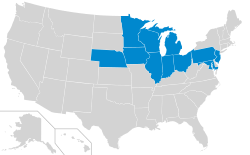
Back اتحاد العشرة الكبار Arabic Big Ten конференци CE Big Ten Conference German Big Ten Conference Spanish Big Ten Conference Basque همایش ۱۰تای بزرگ Persian Big Ten Conference French Big Ten Conference Italian ビッグ・テン・カンファレンス Japanese 빅 텐 콘퍼런스 Korean
 | |
| Formerly | Intercollegiate Conference of Faculty Representatives (officially, 1896–1987) Western Conference (1896–1899) Big Nine (1899–1917, 1946–1950) |
|---|---|
| Association | NCAA |
| Founded | 1896 |
| Commissioner | Tony Petitti |
| Sports fielded |
|
| Division | Division I |
| Subdivision | FBS |
| No. of teams | 14 (18 in 2024) |
| Headquarters | Rosemont, Illinois, U.S. |
| Region | |
| Official website | bigten |
| Locations | |
 | |
The Big Ten Conference (stylized B1G, formerly the Western Conference and the Big Nine Conference) is the oldest Division I collegiate athletic conference in the United States. Founded as the Intercollegiate Conference of Faculty Representatives in 1896, it predates the founding of its regulating organization, the NCAA. It is based in the Chicago area in Rosemont, Illinois. For many decades the conference consisted of 10 prominent universities, which accounts for its name. As of 2014[update], it consists of 14 member institutions and 2 affiliate institutions, with 4 new member institutions scheduled to join in 2024.[1][2] The conference competes in the NCAA Division I and its football teams compete in the Football Bowl Subdivision (FBS), formerly known as Division I-A, the highest level of NCAA competition in that sport.
Big Ten member institutions are major research universities with large financial endowments and strong academic reputations. A large student body is a hallmark of its universities, as 12 of the 14 members enroll more than 30,000 students. They are all public universities except founding member Northwestern University as the lone private university, but will be joined by private University of Southern California at the beginning of the 2024–25 collegiate athletic year. Collectively, Big Ten universities educate more than 520,000 total students and have 5.7 million living alumni.[1] The members engage in $9.3 billion in funded research each year;[2] 13 out of 14 are members of the Association of American Universities and all are members of the Universities Research Association (URA). All Big Ten universities are also members of the Big Ten Academic Alliance, formerly the Committee on Institutional Cooperation.[3]
Although the Big Ten has primarily been a Midwestern conference for nearly a century, the conference's geographic footprint has extended from the Mid-Atlantic to the Great Plains since 2014, and will also have a presence in the West Coast with the addition of four former Pac-12 Conference schools in 2024.[4]
- ^ a b "University of Maryland and Rutgers University Become Official Members of Big Ten Conference". bigten.org. Archived from the original on June 26, 2016. Retrieved June 21, 2016.
- ^ a b "The CIC Welcomes the University of Maryland and Rutgers University to Membership". cic.net. December 28, 2015. Archived from the original on December 28, 2015. Retrieved February 2, 2019.
- ^ "2014 Big Ten Academic Alliance University Data At-A-Glance" (PDF). Big Ten Academic Alliance. Retrieved June 30, 2016.
- ^ Pizzo, Rick (March 2016). "Pizzo: Addition of Notre Dame strengthens Big Ten hockey". BTN.com. Big Ten Network. Retrieved May 31, 2016.